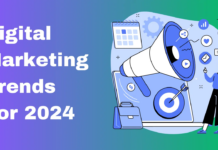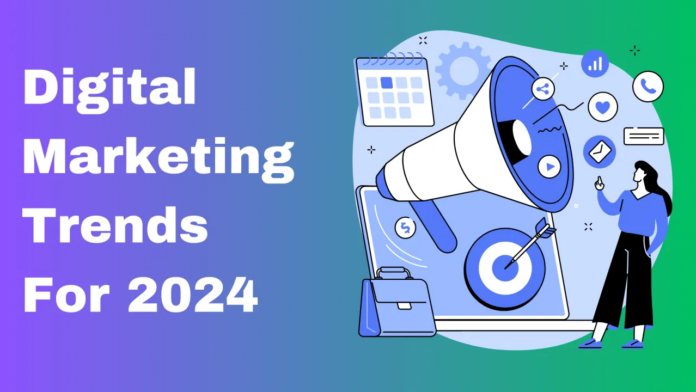As we step to the end of 2024, digital marketing is evolving at a fast pace, driven by new technologies, changing user expectations, and a renewed focus on privacy and sustainability. For businesses and marketers, staying ahead of these trends is essential to build stronger connections with customers and deliver more impactful results. Here’s a look at the top digital marketing trends to watch for this year:
1. AI-Powered Personalization: Making Customer Experiences Smarter
AI continues to transform digital marketing by personalizing content, optimizing ad targeting, and enhancing user interactions. In 2024, AI tools will help brands reach customers with hyper-targeted content that resonates. For instance, machine learning algorithms can analyze user behavior to predict needs, while tools like ChatGPT can help create tailored messages quickly and efficiently.
To implement this trend:
- Use AI-powered tools for segmentation and to automate product recommendations.
- Explore chatbots for instant customer support and lead generation.
2. Optimizing for Voice and Visual Search
With the rise of smart speakers and voice-activated search, optimizing for voice search is essential. Users are increasingly relying on conversational queries, which means brands need to consider natural language in SEO strategies. Similarly, visual search, where users upload an image to search for similar items, is becoming popular. Platforms like Google Lens and Pinterest have made this possible, and brands that adapt to visual search will gain a competitive edge.
To implement this trend:
- Focus on question-based keywords and phrases to optimize for voice search.
- Incorporate high-quality images and use image SEO techniques, such as adding alt text, to optimize for visual search.
3. Short-Form Video and Vertical Content Dominate
Short-form, vertical videos are here to stay. With TikTok, Instagram Reels, and YouTube Shorts taking center stage, brands can capture attention quickly with concise, engaging videos that are easy to consume. This format works well for educational content, “how-to” tips, and behind-the-scenes glimpses into your brand.
To implement this trend:
- Create short, value-driven videos that engage viewers immediately.
- Experiment with mobile-first content strategies to capture users’ attention on the go.
4. Conversational Marketing with Advanced Chatbots
As consumers increasingly expect instant responses, conversational marketing through chatbots is becoming vital. With advancements in natural language processing (NLP), chatbots can now offer human-like responses and guide users through personalized experiences. This is particularly useful for lead generation, customer support, and e-commerce assistance.
To implement this trend:
- Use chatbots on your website or social channels to respond to common questions.
- Personalize chatbot responses to improve customer experience and gather insights.
5. Purpose-Driven and Sustainable Branding
Modern consumers are choosing brands that align with their values, making sustainability and purpose-driven branding essential. Highlighting your environmental initiatives and social impact efforts is no longer just an option; it’s becoming a priority. Brands that focus on transparency, authenticity, and sustainable practices will resonate more with today’s audience.
To implement this trend:
- Share stories about your sustainability practices and ethical sourcing.
- Highlight social causes you support, showing how your brand is committed to making a positive impact.
6. Privacy-First Marketing and Data Transparency
With the phasing out of third-party cookies and new privacy regulations, marketers must shift to privacy-first strategies. Consumers are more aware of data privacy and appreciate brands that protect their information. This year, expect to see a focus on first-party data (data collected directly from users) and zero-party data (information users willingly share, like surveys and polls).
To implement this trend:
- Encourage users to share information directly through engaging surveys or preferences.
- Focus on building trust with transparent privacy policies and clear data use explanations.
7. Augmented Reality (AR) and Immersive Experiences
AR is enhancing how customers interact with products online. From trying on clothing virtually to visualizing how furniture fits in a room, AR is making online shopping more interactive. Additionally, with the development of the metaverse, brands are starting to experiment with immersive experiences to engage customers in digital environments.
To implement this trend:
- Use AR for virtual try-ons, previews, or demos on your website or social media.
- Create unique, immersive content that allows users to engage with your brand in a new way.
8. User-Generated Content (UGC) and Influencer Marketing
User-generated content and influencer marketing are powerful ways to build trust and foster authenticity. Consumers are more likely to trust content from real users or influencers who align with their values. In 2024, the emphasis will be on working with micro-influencers and leveraging authentic UGC, which can drive engagement and attract niche audiences.
To implement this trend:
- Encourage users to create content featuring your products and share it on social media.
- Partner with micro-influencers who have loyal, engaged audiences.
9. Interactive Content for Higher Engagement
Static content is losing ground to interactive experiences that actively involve users. Quizzes, polls, surveys, and interactive infographics are great for engaging users and keeping them on your page longer. Interactive content also provides real-time data and feedback, helping you understand customer preferences better.
To implement this trend:
- Integrate quizzes, polls, and surveys into your content marketing strategy.
- Use interactive infographics to share complex data in a more digestible way.
10. Focus on Customer Retention through Loyalty Programs
In 2024, brands are prioritizing customer retention to foster loyalty and build long-term relationships. With rising acquisition costs, retention strategies such as loyalty programs, subscription models, and post-purchase follow-ups are essential. Personalized email marketing can help keep your brand top of mind for existing customers, providing exclusive offers and updates.
To implement this trend:
- Develop a loyalty program to reward repeat customers and keep them engaged.
- Use personalized email marketing to reach out to customers with tailored messages and incentives.
Wrapping Up: 2024 is About Meaningful Connections
As we move into 2024, digital marketing will be about creating value-driven and meaningful interactions. From AI personalization to privacy-first marketing, each of these trends reflects a shift towards a customer-centric approach that prioritizes trust, authenticity, and engaging experiences. By embracing these trends, brands can connect with their audience in new and innovative ways, driving growth and success in the digital space.
What’s Next? Think about how your brand can adapt to these trends and start implementing changes that align with your goals and audience needs. As the digital landscape continues to evolve, staying agile and responsive will be key to thriving in the year ahead!



















